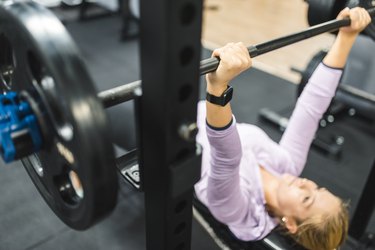
There's no doubt that the bench press is a legendary exercise, but even the most fabled legends aren't perfect. After 50 years of gym dominance — and verifiable benefits for building strength and sculpting the pecs — the barbell bench press isn't going anywhere, but it's worth a nuanced view.
Like a flat bench, a decline bench press has the potential to build both upper body power and muscle, but it doesn't recruit key shoulder muscles and it may even cause shoulder strain. As a subtle variation on a classic, the decline bench press comes with some naturally subtle perks and drawbacks of its own, too.
Video of the Day
Video of the Day
Decline Bench Press: Potential Perks
The decline bench press primarily targets the lower part of the pectoralis major muscles. To a lesser extent, it also works the upper pectoralis major, anterior deltoids and triceps. The biceps muscles on the front of your upper arms work as stabilizers during the movement.
Bench press die-hards invented the decline bench press for a reason, and that reason is that they wanted a more intense focus on stimulating the chest muscles. Though the jury is still out on whether the decline press is conclusively better than the flat bench in that regard, some may experience more stimulation — especially in the lower chest — due to the exercise's greater range of motion.
Read more: Alternative Exercises for Bench Pressing
Decline Bench Press: Possible Pitfalls
Though the lowered position of the decline press aims to boost your range of motion, you can seriously stunt that range if your grip is too wide. As a rule of thumb, your forearms should be pretty much vertical at the bottom of a rep, with an overhand grip for a standard decline press.
The bench press activates the front shoulder muscles known as the anterior deltoids as synergists, or muscles that help other muscles complete a movement, but a declined angle may reduce the focus on the delts.
Versus the Incline
You can't have a conversation about the decline bench press without mentioning its sister, the incline bench press, which puts the bench at a raised (rather than lowered) angle.
Both offer similar overall engagement of the clavicular head of the chest (the upper pecs), but the flat and decline positions recruit the sternocostal head muscles (the lower pecs) a bit more than the incline press, according to a June 2017 study published by Journal of Human Kinetics. For the latter, a bench angled between -18 and 0 degrees offers the most impact.
The same study found that decline bench press six-repetition max performance improved with a wider grip position versus narrow or medium grips.
If you're looking to work the triceps, a secondary muscle group engaged by the bench press, decline and flat bench angles are your best bet, versus an incline bench press, which causes increased activation of the biceps brachii.
Read more: Decline Crunches vs. Decline Sit-Ups
The Bottom Line
To maximize physical performance, include incline, flat and decline bench presses in your training routine. As an added bonus, varying this exercise can reduce overall stress through your shoulders, elbows and wrists as each one targets chest and arm muscles a little differently.